arson
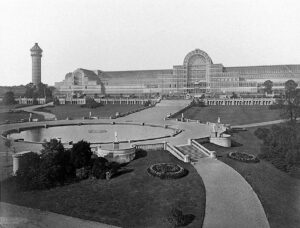
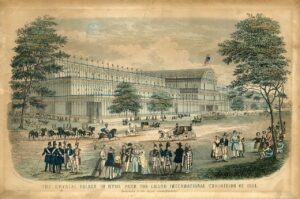 Every time there is a great event like the Olympics, the World’s Fair, or in this case, the Great Exhibition, a stunning new building or structure is built to house the event. The Crystal Palace was originally located in Hyde Park, London, England. It was a cast iron and plate glass structure, built to house the Great Exhibition of 1851. The Great Exhibition took place from May 1 to October 15, 1851, with more than 14,000 exhibitors from around the world gathered in its 990,000 square feet exhibition hall to display their own examples of the latest technology they had developed in the Industrial Revolution. The Crystal Palace was designed by Joseph Paxton. It was 1,851 feet long, with an interior height of 128 feet. It was three times the size of Saint Paul’s Cathedral. Some say that the name of the building came from a piece penned by the playwright Douglas Jerrold, who in July 1850 wrote in the satirical magazine Punch about the forthcoming Great Exhibition, referring to a “palace of very crystal.”
Every time there is a great event like the Olympics, the World’s Fair, or in this case, the Great Exhibition, a stunning new building or structure is built to house the event. The Crystal Palace was originally located in Hyde Park, London, England. It was a cast iron and plate glass structure, built to house the Great Exhibition of 1851. The Great Exhibition took place from May 1 to October 15, 1851, with more than 14,000 exhibitors from around the world gathered in its 990,000 square feet exhibition hall to display their own examples of the latest technology they had developed in the Industrial Revolution. The Crystal Palace was designed by Joseph Paxton. It was 1,851 feet long, with an interior height of 128 feet. It was three times the size of Saint Paul’s Cathedral. Some say that the name of the building came from a piece penned by the playwright Douglas Jerrold, who in July 1850 wrote in the satirical magazine Punch about the forthcoming Great Exhibition, referring to a “palace of very crystal.”
The design called for 60,000 panes of glass to adorn the building. On average, a team of 80 men could fix more than 18,000 panes of sheet glass in a week. These were manufactured by the Chance Brothers. The building was finished in 39 weeks. The Crystal Palace boasted the greatest area of glass ever seen in a building. Visitors were shocked and astonished by all the clear walls and ceilings that did not require interior lights. The interior of the building had full grown trees!! The full-size elm trees that had been growing in the park were simply enclosed within the central exhibition hall near the 27-foot-tall Crystal Fountain. While very nice looking, the trees caused a problem with sparrows becoming a nuisance, and of course, shooting was out of the question inside a glass building. When Queen Victoria mentioned this problem to the Duke of Wellington, he offered the solution, “Sparrowhawks, Ma’am.” Now to me, that is incredulous, because you would simply be replacing on kind of bird with another, and then there was the added problem of bird violence. I don’t think the visitors would be very thrilled about the fighting birds or dropping bodies.
Incredibly, the Palace was relocated after the Great Exhibition, to an open area of South London known as Penge Place which had been excised from Penge Common. The building was rebuilt at the top of Penge Peak next to Sydenham Hill, which is an affluent suburb. The Crystal Palace stood in that location from June 1854 until a fire destroyed it in November 1936. After the fire, the suburb was renamed Crystal Palace after the landmark. In addition, a park was placed in the area and named Crystal Palace Park. It surrounds the site, and is home of the Crystal Palace National Sports Centre, which was previously a football stadium that hosted the FA Cup Final between 1895 and 1914. Crystal Palace Football Club were founded at the site and played at the Cup Final venue in their early years. The site still contains Benjamin Waterhouse Hawkins’s Crystal Palace Dinosaurs which date back to 1854.
In the 1920s, a board of trustees was set up under the guidance of manager Sir Henry Buckland. Buckland was a fair man with a great love for the Crystal Palace, decided to restore the building. Following the restoration, the visitors returned, and the Crystal Palace started to become profitable again. Buckland and his staff also worked on improving the fountains and gardens, including the Thursday evening displays of fireworks by Brocks. Then, on the evening of November 30, 1936, Buckland was walking his dog near the Palace with his daughter Crystal. Buckland had named her after the building. Always looking at the building he loved, they noticed a red glow coming from inside. Buckland went in to investigate and found two of his employees fighting a small office fire that had started after an explosion in the women’s cloakroom. Buckland could see that this was a serious fire, so they called the Penge fire brigade. It was too late. Even with the 89 fire engines and over 400 firemen, the fire was too big and too out of control to be able to extinguish it.
The infamous Crystal Palace was destroyed. The fire was so big that its glow could be seen across eight counties. With high winds that night, the fire spread quickly, and in part because of the dry old timber flooring, and the huge quantity of flammable materials in the building it burned to the ground. Buckland said, “In a few hours we have seen the end of the Crystal Palace. Yet, it will live in the memories not only of Englishmen, but the whole world.” The fire brought one-hundred thousand spectators to Sydenham Hill that night. One of the 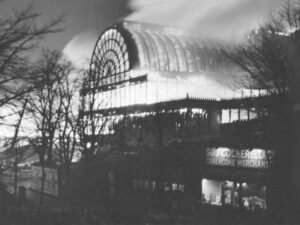
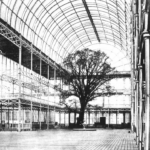 spectators was Winston Churchill, who said, “This is the end of an age.” Unfortunately, as was common for the era, the Crystal Palace was underinsured, and with a potential rebuild cost of at least £2 million, the building was never rebuilt. John Logie Baird, who had used the South Tower and much of the lower level of the building for mechanical television experiments. Much of his work was destroyed in the fire, and Baird suspected the fire was an act of arson to destroy his work on developing television. Nevertheless, the true cause remains unknown.
spectators was Winston Churchill, who said, “This is the end of an age.” Unfortunately, as was common for the era, the Crystal Palace was underinsured, and with a potential rebuild cost of at least £2 million, the building was never rebuilt. John Logie Baird, who had used the South Tower and much of the lower level of the building for mechanical television experiments. Much of his work was destroyed in the fire, and Baird suspected the fire was an act of arson to destroy his work on developing television. Nevertheless, the true cause remains unknown.
 These days there aren’t many people who haven’t heard of the Santa Ana winds, the California wildfires, or this year, the burning of Australia. We hear all about how global warming is the cause of the tragic fires and loss of both vegetation and life, human and animal. I agree with the analogy that the fires in Australia are horrific, but the cause…well, that has been determined to be, not global warming, draught, or lightning, but rather arson…ARSON!! Disgusting just isn’t a big enough word for what that is.
These days there aren’t many people who haven’t heard of the Santa Ana winds, the California wildfires, or this year, the burning of Australia. We hear all about how global warming is the cause of the tragic fires and loss of both vegetation and life, human and animal. I agree with the analogy that the fires in Australia are horrific, but the cause…well, that has been determined to be, not global warming, draught, or lightning, but rather arson…ARSON!! Disgusting just isn’t a big enough word for what that is.
I can’t imagine why anyone would choose to burn something…anything. You can call it a sickness, and maybe it is, but that cannot be an excuse. If we allow such an excuse, more and more people will use it, take out their frustrations on things around them, and then expect to be excused because they are “sick.” At this point, firefighters are battling wildfires across Australia. Meanwhile, the police in New South Wales have arrested  dozens of people for offenses related to fires, including 24 for deliberately lighting fires and three for looting fire-ravaged communities. There is also a story saying that 183 to 200 people are suspected of “fire-related offenses since November 8th, including for ‘allegedly discarding a lighted cigarette or match on land,’ but no verification as to the exact charges being lodged.
dozens of people for offenses related to fires, including 24 for deliberately lighting fires and three for looting fire-ravaged communities. There is also a story saying that 183 to 200 people are suspected of “fire-related offenses since November 8th, including for ‘allegedly discarding a lighted cigarette or match on land,’ but no verification as to the exact charges being lodged.
It is sad that the most common motive for wildfire arson is crime concealment. Fires are set for the purpose of covering up a murder or burglary or to eliminate evidence left at a crime scene. Fires have also been known to be set to further social, political, or religious causes. The fire set to cover up a crime, while horrific, is at least explainable, but fires set for political, social, or religious reasons is completely disgusting. There is just no excuse for the loss of homes businesses, and lives, human and animal, that could excuse such destruction. One fire, set to cover up a crime is reasonable, though disgusting, but these are all over Australia. And while one 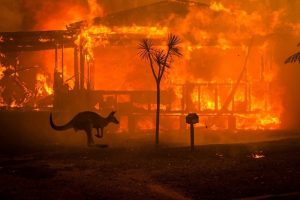 person might be a “sick” arsonist, to find 24 to 200 “sick” arsonists, is not even possible. The other thought that makes me so mad I could scream, is that even if this is socially, politically, or religiously motivated, what is the point? What are they trying to prove? All I can say is, that I hope they find the people who did this and that they give them the maximum sentence possible. I don’t know Australian law, so I don’t know if they have the death penalty or not, but I think these people should get it, if they do. And if not, solitary confinement for the rest of their lives might…just might, be punishment enough, but I really doubt it.
person might be a “sick” arsonist, to find 24 to 200 “sick” arsonists, is not even possible. The other thought that makes me so mad I could scream, is that even if this is socially, politically, or religiously motivated, what is the point? What are they trying to prove? All I can say is, that I hope they find the people who did this and that they give them the maximum sentence possible. I don’t know Australian law, so I don’t know if they have the death penalty or not, but I think these people should get it, if they do. And if not, solitary confinement for the rest of their lives might…just might, be punishment enough, but I really doubt it.

